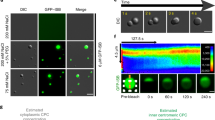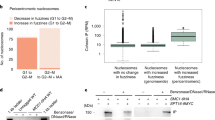Abstract
Chromosome structure is dynamically regulated during cell division, and this regulation is dependent, in part, on condensin. The localization of condensin at chromosome arms is crucial for chromosome partitioning during anaphase. Condensin is also enriched at kinetochores but its precise role and loading machinery remain unclear. Here we show that fission yeast (Schizosaccharomyces pombe) kinetochore proteins Pcs1 and Mde4—homologues of budding yeast (Saccharomyces cerevisiae) monopolin subunits and known to prevent merotelic kinetochore orientation—act as a condensin ‘recruiter’ at kinetochores, and that condensin itself may act to clamp microtubule binding sites during metaphase. In addition to the regional recruitment factors, overall condensin association with chromatin is governed by the chromosomal passenger kinase Aurora B. Aurora-B-dependent phosphorylation of condensin promotes its association with histone H2A and H2A.Z, which we identify as conserved chromatin ‘receptors’ of condensin. Condensin phosphorylation and its deposition onto chromosome arms reach a peak during anaphase, when Aurora B kinase relocates from centromeres to the spindle midzone, where the separating chromosome arms are positioned. Our results elucidate the molecular basis for the spatiotemporal regulation of mitotic chromosome architecture, which is crucial for chromosome partitioning.
This is a preview of subscription content, access via your institution
Access options
Subscribe to this journal
Receive 51 print issues and online access
$199.00 per year
only $3.90 per issue
Buy this article
- Purchase on Springer Link
- Instant access to full article PDF
Prices may be subject to local taxes which are calculated during checkout





Similar content being viewed by others
Change history
12 June 2011
The Supplementary Information PDF was replaced.
References
Hirano, T. Condensins: organizing and segregating the genome. Curr. Biol. 15, R265–R275 (2005)
Hudson, D. F., Marshall, K. M. & Earnshaw, W. C. Condensin: Architect of mitotic chromosomes. Chromosome Res. 17, 131–144 (2009)
Koshland, D. & Strunnikov, A. Mitotic chromosome condensation. Annu. Rev. Cell Dev. Biol. 12, 305–333 (1996)
Ono, T., Fang, Y., Spector, D. L. & Hirano, T. Spatial and temporal regulation of condensins I and II in mitotic chromosome assembly in human cells. Mol. Biol. Cell 15, 3296–3308 (2004)
Oliveira, R. A., Coelho, P. A. & Sunkel, C. E. The condensin I subunit Barren/CAP-H is essential for the structural integrity of centromeric heterochromatin during mitosis. Mol. Cell. Biol. 25, 8971–8984 (2005)
Samoshkin, A. et al. Human condensin function is essential for centromeric chromatin assembly and proper sister kinetochore orientation. PLoS ONE 4, e6831 (2009)
Ribeiro, S. A. et al. Condensin regulates the stiffness of vertebrate centromeres. Mol. Biol. Cell 20, 2371–2380 (2009)
Nakazawa, N. et al. Dissection of the essential steps for condensin accumulation at kinetochores and rDNAs during fission yeast mitosis. J. Cell Biol. 180, 1115–1131 (2008)
Nasmyth, K. & Haering, C. H. Cohesin: its roles and mechanisms. Annu. Rev. Genet. 43, 525–558 (2009)
Gerlich, D., Hirota, T., Koch, B., Peters, J. M. & Ellenberg, J. Condensin I stabilizes chromosomes mechanically through a dynamic interaction in live cells. Curr. Biol. 16, 333–344 (2006)
Hudson, D. F. et al. Molecular and genetic analysis of condensin function in vertebrate cells. Mol. Biol. Cell 19, 3070–3079 (2008)
Iwasaki, O., Tanaka, A., Tanizawa, H., Grewal, S. I. & Noma, K. Centromeric localization of dispersed Pol III genes in fission yeast. Mol. Biol. Cell 21, 254–265 (2010)
D’Ambrosio, C. et al. Identification of cis-acting sites for condensin loading onto budding yeast chromosomes. Genes Dev. 22, 2215–2227 (2008)
Johzuka, K. & Horiuchi, T. The cis element and factors required for condensin recruitment to chromosomes. Mol. Cell 34, 26–35 (2009)
Rabitsch, K. P. et al. Kinetochore recruitment of two nucleolar proteins is required for homolog segregation in meiosis I. Dev. Cell 4, 535–548 (2003)
Takemoto, A. et al. The chromosomal association of condensin II is regulated by a noncatalytic function of PP2A. Nature Struct. Mol. Biol. 16, 1302–1308 (2009)
Liu, W. et al. PHF8 mediates histone H4 lysine 20 demethylation events involved in cell cycle progression. Nature 466, 508–512 (2010)
Bazile, F., St-Pierre, J. & D’Amours, D. Three-step model for condensin activation during mitotic chromosome condensation. Cell Cycle 9, 3243–3255 (2010)
Ruchaud, S., Carmena, M. & Earnshaw, W. C. Chromosomal passengers: conducting cell division. Nature Rev. Mol. Cell Biol. 8, 798–812 (2007)
Giet, R. & Glover, D. M. Drosophila aurora B kinase is required for histone H3 phosphorylation and condensin recruitment during chromosome condensation and to organize the central spindle during cytokinesis. J. Cell Biol. 152, 669–682 (2001)
Hagstrom, K. A., Holmes, V. F., Cozzarelli, N. R. & Meyer, B. J. C. elegans condensin promotes mitotic chromosome architecture, centromere organization, and sister chromatid segregation during mitosis and meiosis. Genes Dev. 16, 729–742 (2002)
Kaitna, S., Pasierbek, P., Jantsch, M., Loidl, J. & Glotzer, M. The Aurora B kinase AIR-2 regulates kinetochores during mitosis and is required for separation of homologous chromosomes during meiosis. Curr. Biol. 12, 798–812 (2002)
Petersen, J. & Hagan, I. M. S. pombe Aurora kinase/survivin is required for chromosome condensation and the spindle checkpoint attachment response. Curr. Biol. 13, 590–597 (2003)
Lavoie, B. D., Hogan, E. & Koshland, D. In vivo requirements for rDNA chromosome condensation reveal two cell-cycle-regulated pathways for mitotic chromosome folding. Genes Dev. 18, 76–87 (2004)
Takemoto, A. et al. Analysis of the role of Aurora B on the chromosomal targeting of condensin I. Nucleic Acids Res. 35, 2403–2412 (2007)
Lipp, J. J., Hirota, T., Poser, I. & Peters, J. M. Aurora B controls the association of condensin I but not condensin II with mitotic chromosomes. J. Cell Sci. 120, 1245–1255 (2007)
Mora-Bermúdez, F., Gerlich, D. & Ellenberg, J. Maximal chromosome compaction occurs by axial shortening in anaphase and depends on Aurora kinase. Nature Cell Biol. 9, 822–831 (2007)
Hsu, J. Y. et al. Mitotic phosphorylation of histone H3 is governed by Ipl1/aurora kinase and Glc7/PP1 phosphatase in budding yeast and nematodes. Cell 102, 279–291 (2000)
Murnion, M. E. et al. Chromatin-associated protein phosphatase 1 regulates aurora-B and histone H3 phosphorylation. J. Biol. Chem. 276, 26656–26665 (2001)
Corbett, K. D. et al. The monopolin complex crosslinks kinetochore components to regulate chromosome-microtubule attachments. Cell 142, 556–567 (2010)
Gregan, J. et al. The kinetochore proteins Pcs1 and Mde4 and heterochromatin are required to prevent merotelic orientation. Curr. Biol. 17, 1190–1200 (2007)
Yokobayashi, S. & Watanabe, Y. The kinetochore protein Moa1 enables cohesion-mediated monopolar attachment at meiosis I. Cell 123, 803–817 (2005)
Saka, Y. et al. Fission yeast cut3 and cut14, members of a ubiquitous protein family, are required for chromosome condensation and segregation in mitosis. EMBO J. 13, 4938–4952 (1994)
Haeusler, R. A., Pratt-Hyatt, M., Good, P. D., Gipson, T. A. & Engelke, D. R. Clustering of yeast tRNA genes is mediated by specific association of condensin with tRNA gene transcription complexes. Genes Dev. 22, 2204–2214 (2008)
Hauf, S. et al. Aurora controls sister kinetochore mono-orientation and homolog bi-orientation in meiosis-I. EMBO J. 26, 4475–4486 (2007)
Koch, A., Krug, K., Pengelley, S., Macek, B. & Hauf, S. Mitotic substrates of the kinase Aurora with roles in chromatin regulation identified through quantitative phosphoproteomics of fission yeast. Sci. Signal. doi:10.1126/scisignal.2001588. (in the press)
Rangasamy, D., Greaves, I. & Tremethick, D. J. RNA interference demonstrates a novel role for H2A.Z in chromosome segregation. Nature Struct. Mol. Biol. 11, 650–655 (2004)
Kim, H. S. et al. An acetylated form of histone H2A.Z regulates chromosome architecture in Schizosaccharomyces pombe . Nature Struct. Mol. Biol. 16, 1286–1293 (2009)
Buchanan, L. et al. The Schizosaccharomyces pombe JmjC-protein, Msc1, prevents H2A.Z localization in centromeric and subtelomeric chromatin domains. PLoS Genet. 5, e1000726 (2009)
Fuller, B. G. et al. Midzone activation of aurora B in anaphase produces an intracellular phosphorylation gradient. Nature 453, 1132–1136 (2008)
Miller, K. M. & Cooper, J. P. The telomere protein Taz1 is required to prevent and repair genomic DNA breaks. Mol. Cell 11, 303–313 (2003)
Brito, I. L., Yu, H. G. & Amon, A. Condensins promote coorientation of sister chromatids during meiosis I in budding yeast. Genetics 185, 55–64 (2010)
Petronczki, M. et al. Monopolar attachment of sister kinetochores at meiosis I requires casein kinase 1. Cell 126, 1049–1064 (2006)
Talbert, P. B. & Henikoff, S. Histone variants—ancient wrap artists of the epigenome. Nature Rev. Mol. Cell Biol. 11, 264–275 (2010)
Parra, M. A. & Wyrick, J. J. Regulation of gene transcription by the histone H2A N-terminal domain. Mol. Cell. Biol. 27, 7641–7648 (2007)
Aono, N., Sutani, T., Tomonaga, T., Mochida, S. & Yanagida, M. Cnd2 has dual roles in mitotic condensation and interphase. Nature 417, 197–202 (2002)
Tanaka, T. U. Kinetochore-microtubule interactions: steps towards bi-orientation. EMBO J. 29, 4070–4082 (2010)
Renshaw, M. J. et al. Condensins promote chromosome recoiling during early anaphase to complete sister chromatid separation. Dev. Cell 19, 232–244 (2010)
Neurohr, G. et al. A midzone-based ruler adjusts chromosome compaction to anaphase spindle length. Science 332, 465–468 (2011)
Dougherty, W. G., Cary, S. M. & Parks, T. D. Molecular genetic analysis of a plant virus polyprotein cleavage site: a model. Virology 171, 356–364 (1989)
Bähler, J. et al. Heterologous modules for efficient and versatile PCR-based gene targeting in Schizosaccharomyces pombe . Yeast 14, 943–951 (1998)
Yokobayashi, S., Yamamoto, M. & Watanabe, Y. Cohesins determine the attachment manner of kinetochores to spindle microtubules at meiosis I in fission yeast. Mol. Cell. Biol. 23, 3965–3973 (2003)
Sakuno, T., Tada, K. & Watanabe, Y. Kinetochore geometry defined by cohesion within the centromere. Nature 458, 852–858 (2009)
Hiraoka, Y., Toda, T. & Yanagida, M. The NDA3 gene of fission yeast encodes β-tubulin: a cold-sensitive nda3 mutation reversibly blocks spindle formation and chromosome movement in mitosis. Cell 39, 349–358 (1984)
Takayama, Y. et al. Biphasic incorporation of centromeric histone CENP-A in fission yeast. Mol. Biol. Cell 19, 682–690 (2008)
Nonaka, N. et al. Recruitment of cohesin to heterochromatic regions by Swi6/HP1 in fission yeast. Nature Cell Biol. 4, 89–93 (2002)
Kawashima, S. A. et al. Shugoshin enables tension-generating attachment of kinetochores by loading Aurora to centromeres. Genes Dev. 21, 420–435 (2007)
Kitajima, T. S. et al. Shugoshin collaborates with protein phosphatase 2A to protect cohesin. Nature 441, 46–52 (2006)
Acknowledgements
We thank S. Hauf for critically reading the manuscript and K.-i. Noma, T. Hirano and the Yeast Genetic Resource Center (YGRC) for yeast strains or reagents. We also thank S. Hauf and M. Yanagida for communicating unpublished results, and all the members of our laboratory for their support and discussion. This work was supported in part by Global COE Program (Integrative Life Science Based on the Study of Biosignaling Mechanisms) (to K.T. and H.S.), Special Coordination Funds for Promoting Science and Technology (to T.S.) and a Grant-in-Aid for Specially Promoted Research, MEXT, Japan (to Y.W.).
Author information
Authors and Affiliations
Contributions
K.T., supported by T.S., performed most of the experiments using fission yeast cells and proteins. H.S. performed all experiments using human cells or proteins. Experimental design and interpretation of data were conducted by all authors. Y.W. supervised the project and K.T. and Y.W. wrote the paper.
Corresponding author
Ethics declarations
Competing interests
The authors declare no competing financial interests.
Supplementary information
Supplementary Information
The file contains Supplementary Table 1, Supplementary Figures 1-25 with legends and additional references. (PDF 1577 kb)
Rights and permissions
About this article
Cite this article
Tada, K., Susumu, H., Sakuno, T. et al. Condensin association with histone H2A shapes mitotic chromosomes. Nature 474, 477–483 (2011). https://doi.org/10.1038/nature10179
Received:
Accepted:
Published:
Issue Date:
DOI: https://doi.org/10.1038/nature10179
This article is cited by
-
Condensin dysfunction is a reproductive isolating barrier in mice
Nature (2023)
-
CCAR2 controls mitotic progression through spatiotemporal regulation of Aurora B
Cell Death & Disease (2022)
-
Ubiquitination of CLIP-170 family protein restrains polarized growth upon DNA replication stress
Nature Communications (2022)
-
NCAPH is a prognostic biomarker and associated with immune infiltrates in lung adenocarcinoma
Scientific Reports (2022)
-
Potential roles of condensin in genome organization and beyond in fission yeast
Journal of Microbiology (2021)
Comments
By submitting a comment you agree to abide by our Terms and Community Guidelines. If you find something abusive or that does not comply with our terms or guidelines please flag it as inappropriate.



